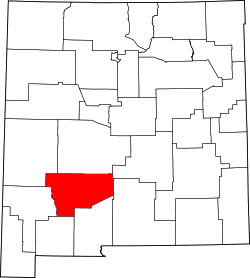History
Las Palomas was one of the offspring settlements of San Ygnacio de la Alamosa, also known as Alamosa, the original native New Mexican settlement, in what became Sierra County, in 1859. After flooding destroyed Alamosa in 1867, many of its residents moved up the Alamosa Creek valley to farm near and live in the new town, called Canada Alamosa. That town had been organized by some earlier residents of Alamosa sometime between 1864 and 1866. [5] : 33–46
Others moved across the river to the east bank and downstream a couple of miles to farm on the opposite side of the river and to start a new town, first called New Alamosa, but that soon became known as Alamocita. Alamocita was six miles north of Fort McRae which was established in April 1863 to protect these new settlements along the Rio Grande Valley from the Apache, along with the traffic along the river and the old road to the east in the Jornada del Muerto. [5] : 42–48, 54–56, 60, 73–76
Also in 1867, a number of the citizens of Canada Alamosa, moved down the Rio Grande to where Palomas Creek had its confluence with the river. There twenty miles south of Fort McRae, it was less exposed to the attacks of the Apache, and easier to reinforce from the fort. There they established the farming settlement first called Plaza del Rio Palomas, later more commonly called Las Palomas. Fort McRae and its garrison would provide its protection and economic benefits to citizens of the towns over the years of its operation until it was closed on October 30, 1876. Las Palomas is the only one of the early New Mexican settlements built along the Rio Grande in Sierra County to survive to the present day despite the river flooding and the construction of reservoirs. [5] : 42–48, 54–56, 60, 73–76
This page is based on this
Wikipedia article Text is available under the
CC BY-SA 4.0 license; additional terms may apply.
Images, videos and audio are available under their respective licenses.

